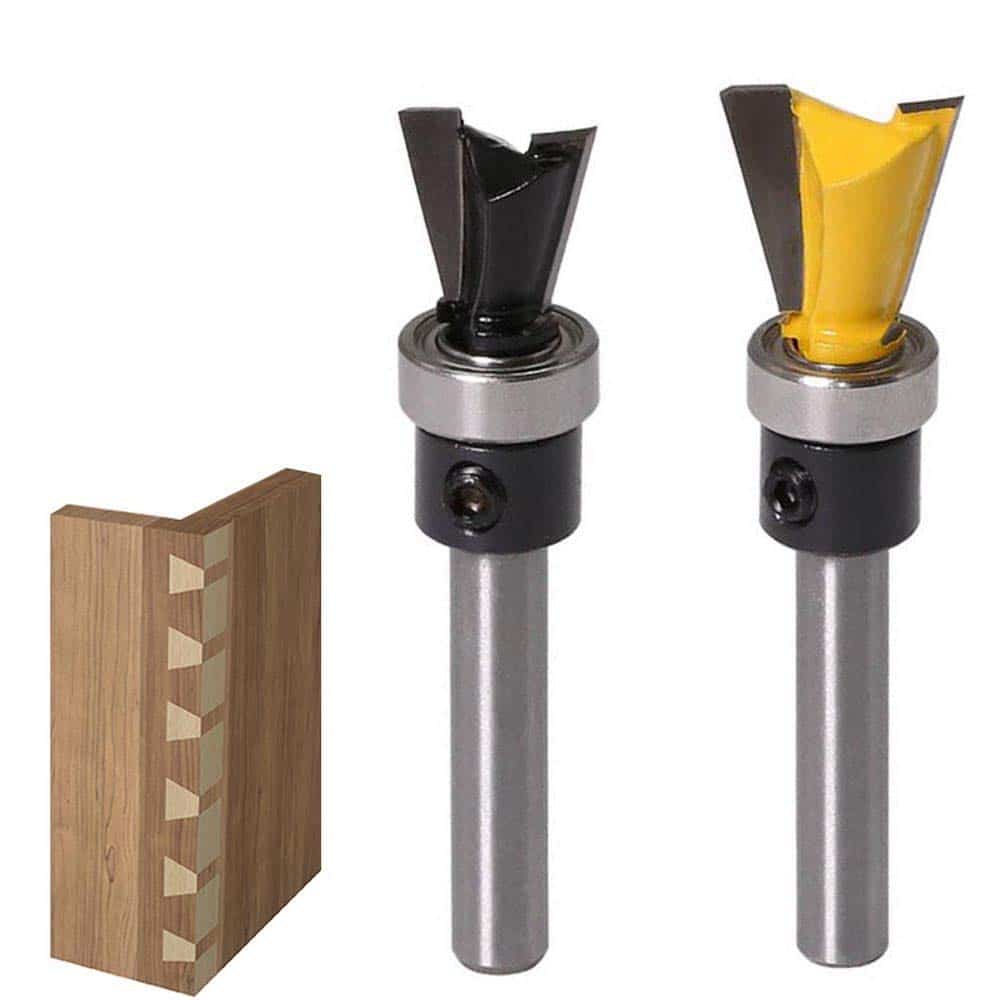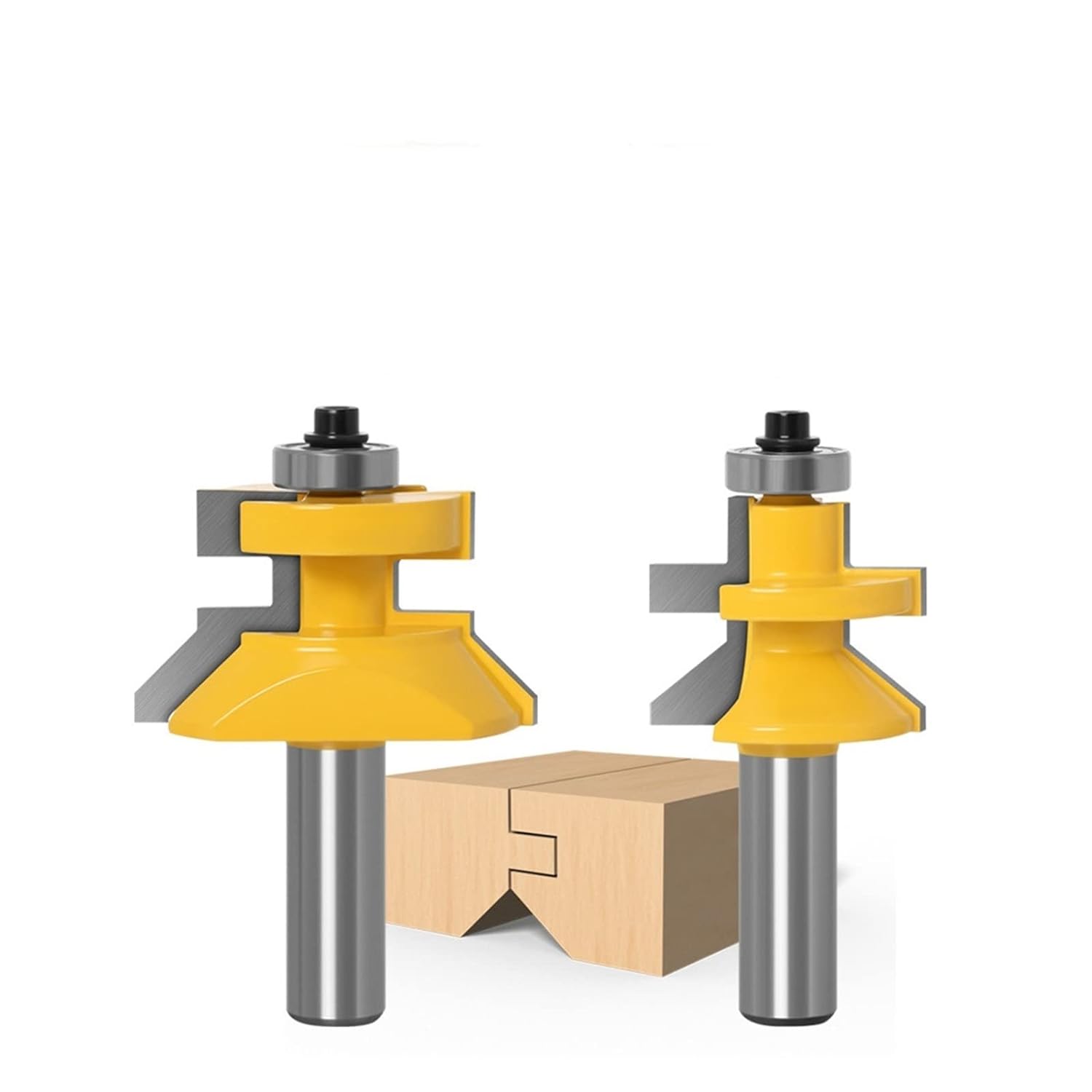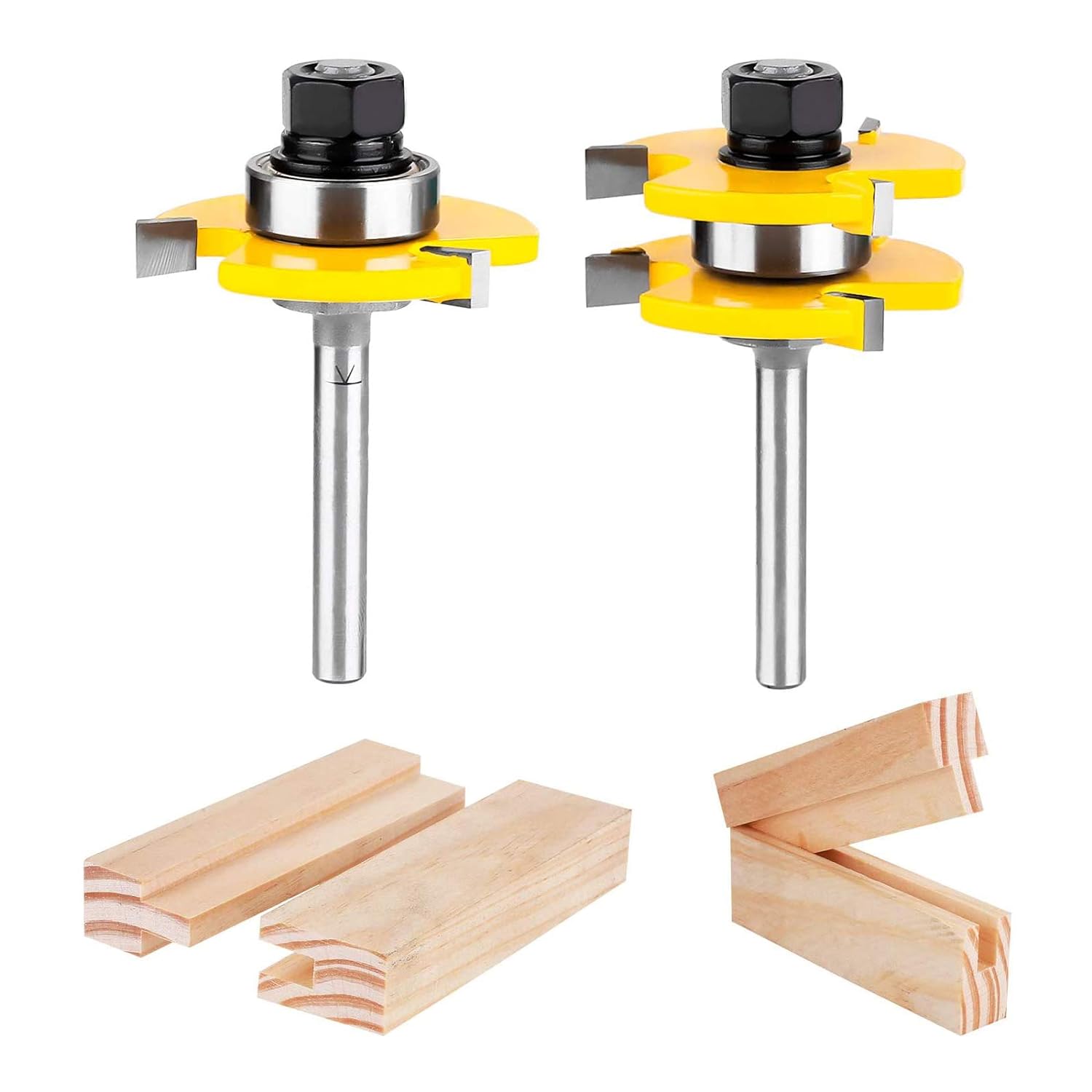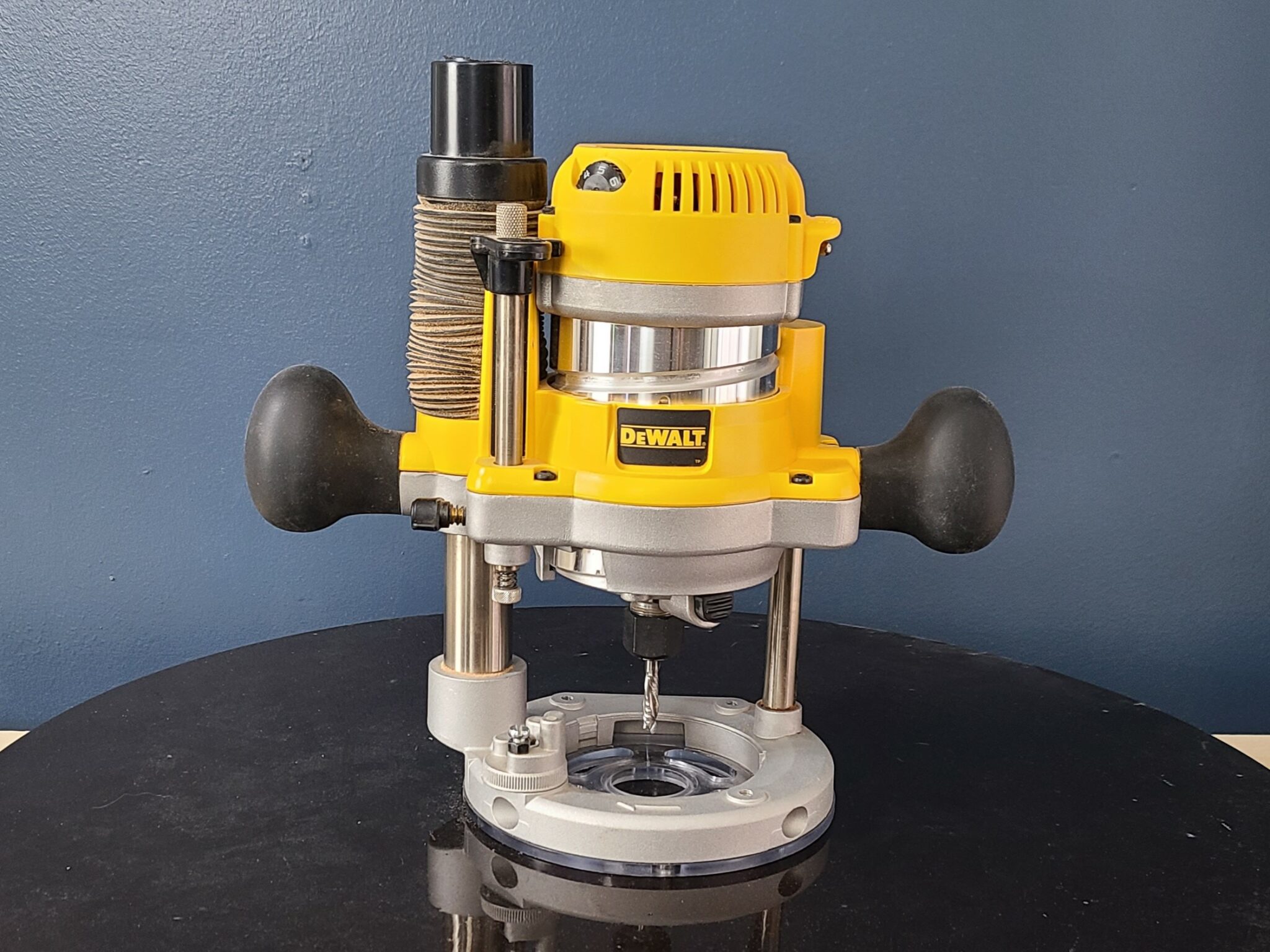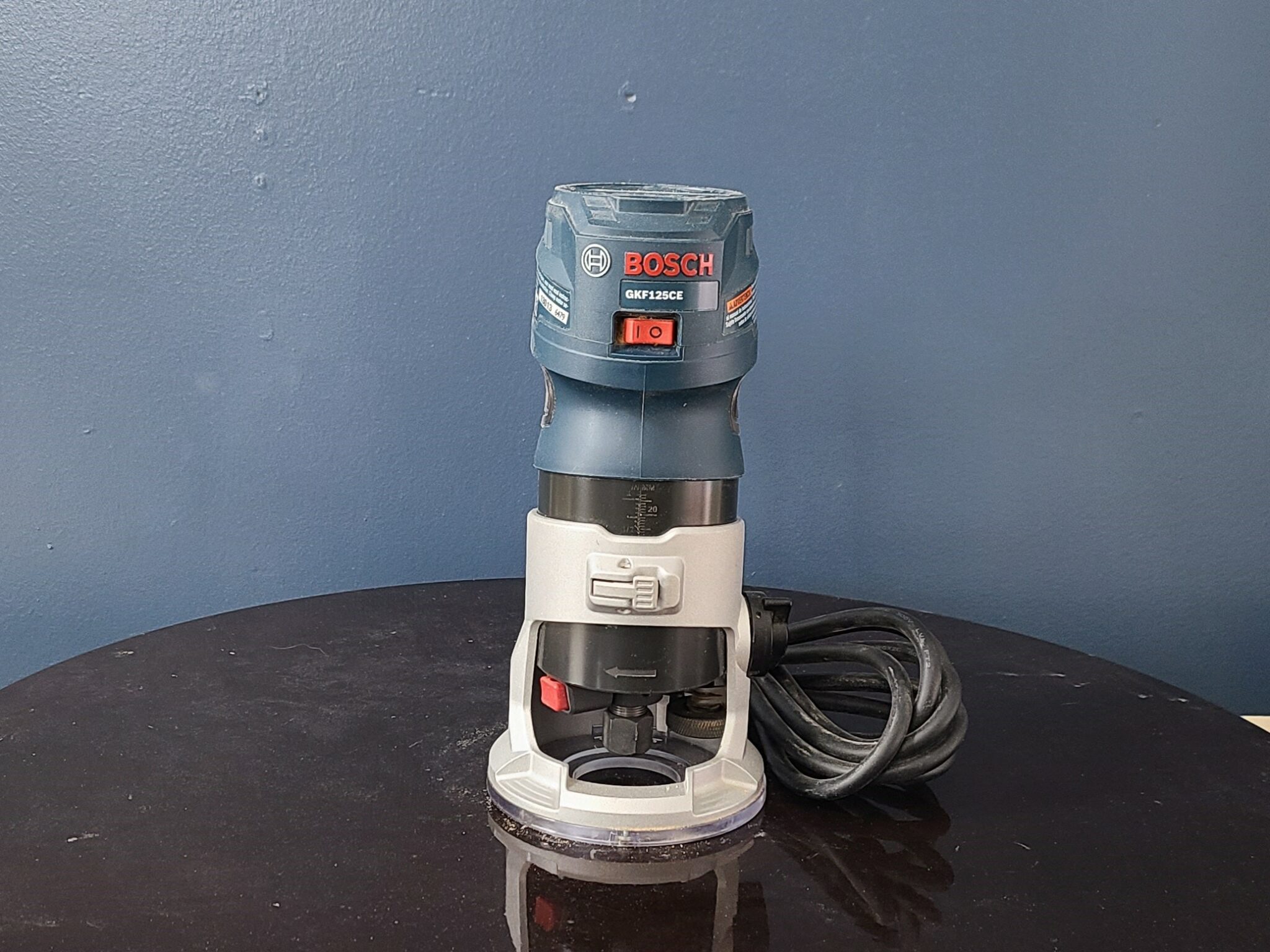The Ultimate Guide to Router Bits: Exploring Types and Applications
Looking to understand what types of router bits you need? Check out this guide to explore the different types, what they’re used for, and understand how to choose the best one for your project.

Disclaimer: This post includes affiliate links, and I will earn a commission if you purchase through these links. Read about our privacy policy.
You’ve got a router, but do you know which bits you need? There are so many different router bit types out there for different applications. It can be confusing. As DIYers, we honestly didn’t get into using routers for a long time even though we owned a router. However, utilizing a router with the correct bit type can be a game-changer for a DIY or woodworking project.
In this comprehensive guide, we’ll dive into the various types of router bits, breaking down their components and exploring their applications.
Understanding the Components of Router Bits
To start, it helps to understand the different components of a router bit. A router bit typically consists of two to three main parts: cutting teeth, a shank, and sometimes a bearing or smooth surface. Let’s explore these components in detail.
Shank
The shank is the part that inserts into the router, so it’s on every type of router bit. It comes in various sizes, with ¼ inch being the most common in the U.S., and more powerful routers supporting ½ inch shanks. Larger shanks reduce deflection during cutting, making them ideal for larger bits and higher horsepower routers.
Cutting Teeth
Cutting teeth simply refers to the cutting edges or blades on the router bit. They’re responsible for cutting the material as the bit rotates in the router.
Bearing
A bearing is a part of the bit that rides along the edge of your workpiece to keep it on course matching the template or piece you have attached. It limits the cutting depth and acts as an edge guide without attaching a straight edge or using a fence. Not all router bits will have a bearing as you can see below.
Exploring Router Bit Types
With countless router bits available, they can be broadly categorized into six main types. Each type serves specific purposes in woodworking and DIY projects.
Straight Bits
Straight bits are the most common bit and are ideal for cutting dados or grooves. They can be bought in standard dimensions or specific plywood sizes for a perfect dado in a single pass.
Characteristics: Straight bits are recognizable by their straight-cutting teeth. These bits are simpler to manufacture, so they tend to be more cost-effective than other types of router bits.
They are more affordable and easier to sharpen but may cause kickback due to the large portion of the blade cutting simultaneously. You are more likely to experience grabbing where the blade enters the wood fibers and then catches them instead of shearing them. This can result in kickback, tearout, or blowout. But don’t worry, you can use simple methods to prevent this.
Tip: Straight bits are often included in starter pack kits, making them a good starting point for beginners. There is nothing wrong with picking up a set of cheap bits and figuring out what your preferred workflow is. Then as the bits wear down, we’d suggest you replace them with spiral bits.
Recommendation:
Get access to our FREE 3D printer router template files.
Spiral Bits / Mortise Bits
Spiral bits, also known as Mortise bits, are router bits that have a spiral blade wrapping around the body. This spiral feature helps minimize chatter and kickback when routing. Spiral bits are ideal for plunge cuts in hardwoods and various other woodworking tasks. There are three varieties of spiral bits, and they are defined based on the angle of their flutes when installed in a handheld router or CNC.
Recommendation:
- ½” Upcut Spiral Bit – pull chips upward, allowing faster cutting and cooler operation but may cause tear-out.
- ½” Downcut Spiral Bit -push chips down, minimizing tear-out, suitable for plywood.
- ¼” Compression Bit – combine upcut and downcut for a balance between the two
Upcut bits
Upcut bits have flutes that spiral up the bit as it cuts. These are similar to drill bits. As it cuts, the bit pulls the chips up and out of the grove. This means an upcut spiral bit can cut faster and run cooler. Unfortunately, this also means you are more likely to get some tear out on the top edge of your groove when cutting plywood or highly figured hardwood like curly maple.
Since the upcut bits run cooler, they are less likely to burn your wood. Combined with their ability to evacuate the wood chips, they are ideal for plunge cuts in hardwoods.
Downcut bits
Downcut spiral bits have flutes that spiral downwards as it cuts. This blows the chips back down into the groove, which can cause the bit to heat up faster, but it means the top edge is sheared downward, resulting in almost no tear-out.
These are best when cutting grooves starting at the edge of a piece so the chips have somewhere to go. And thanks to the bit’s downward shear, it is great for plywood or highly figured woods. Just be sure to stop frequently, so the bit doesn’t get too hot.
Compression bits
The middle ground between these two styles of spiral bits is the compression bit. These bits have teeth arranged in both upcut and downcut. The end of the bit is an upcut so that it pulls chips out of the bottom of the groove you’re routing, while the rest of the bit is a downcut to give you a cleaner edge. The compression spiral bits do require you to make a deep enough pass that you take advantage of both upward and downward geometries, so we wouldn’t recommend this router bit type for thin material.
Where the compression bit really shines is when used with templates as their geometry means you can reduce or eliminate tearout on both edges of your piece.
Flush Trim and Template Bits
Flush trim bits and template bits are standard cutting bits with a bearing on the top or bottom. They can also come in straight or spiral varieties. Flush trim bits are for trimming overhanging material, and template bits are for following templates during cutting.

Flush Trim Bits
A flush trim bit has a bearing at the end of the bit. The intended use of these bits is to allow the bearing to ride on your finished dimension surface and trim any overhanging surface to match. These are particularly useful for trimming laminate, edge banding, or joinery since you can cut your piece oversized and then trim it to be perfect.
Template Bit
A template or pattern bit has the bearing between the cutting blades and the shank. The intended design of these bits is to have the bearing follow a template while cutting into the wood below the template. Next, you can remove the template and plunge deeper to use the surface you just cut as a new template, and then continue to work your way down through the piece.
Tip: These two types of router bits can be used interchangeably depending on the orientation of your template or overhanging surfaces. For example, it is very common to put the template on the top of your piece, and then bring that piece over to a router table where you can use a long flush trim bit to trim the entire piece in one pass.
Recommendation:
Edge Forming / Corner Profiles
Similar to a flush trim bit, edge forming router bits also have a bearing at the end of the bit. However, instead of having standard cutting blades, they have profiled cutting blades. These types of router bits are used to add a specific geometry to the edges of a piece.
Roundover Bits
Roundover bits will add a small curved edge to the wood piece. We use roundover bits on almost every project we do since adding that small curve on the edge greatly enhances the tactile feel of the piece. It just gives that little extra for a professional look. Our favorite sizes are the ⅛” and ¼” roundover bits.
Chamfer Bits
In other cases, we use a chamfer edge-forming bit instead to get that angled aesthetic. Chamber router bits create a consistent angle along the edge of a workpiece to again really elevate the finished look.
Roman Ogee & Cove Bits
There are also a number of fancy profiles that router bits can create, but you probably won’t see them used very often anymore. This includes the Roman Ogee bit that creates decorative S-shaped profiles for items like molding; or Cove bits that create concave quarter circles and are sometimes used on furniture like tables.
Recommendation:
- Beginner Set – includes edge-forming bits
- ⅛” Roundover Bit
- ¼” Roundover Bit
- Chamfer Bit
Joinery Forming Bits
Joinery forming bits are similar to edge-forming bits but focused on creating joints. These router bits also use a bearing and they cut a specific profile into the wood to allow boards to be joined. Depending on the profile, they may come in a male and female set. Examples of these types of router bits are Rabbet bits and Tongue & Groove Bits.
Also included in this category are dovetail bits. You need a special fixture to make accurate use of these, but they can give you perfect dovetails when used correctly.
Tip: Some types have no bearings and require you to set the fence on a router table appropriately.
Recommendation:
- Bosch Quality Router Set – includes dovetail and rabbet bits
Photo credit: Amazon.com
Surface Forming Bits
Finally, there are surface forming bits. These router bits don’t have any guide bearings, so they can be used freehand or with a straight edge. Common examples of these are V groove bits and cove bits. These allow you to cut a specific profile into any surface and are often used decoratively.
Recommendation:
- Bosch Quality Router Set – includes V-groove & cove bits
- KOWOOD Beginner Router Set – includes V-groove & cove bits, but not some other common ones we love.
Choosing the Right Router Bit for the Job
When it comes to woodworking or any project involving materials like plastic or metal, selecting the right router bit is crucial for achieving clean, precise cuts, and the desired results. The market is flooded with various router bits, each designed for specific tasks and materials. Here are a few key considerations to help you make informed decisions when choosing the right router bit for your project.
Material Considerations
One of the primary factors influencing your router bit choice is the material you’re working with. Different bits are designed for specific materials, such as wood, plastic, or metal. Take into account the hardness and density of the material, as this will impact the type of bit that is most suitable for the job. For example, softer woods may require less aggressive bits, while harder materials demand robust and durable options.
Speed and Feed Rates
Matching the router speed to the bit’s recommended speed range is crucial for optimal performance. Some router bits have a specific speed range they can operate in, so you need to ensure your router speed can match the bit’s recommended speed range. Running the router at excessively high speeds can lead to burning and compromise the quality of your cuts. It can also cause more tear-out and dull the router bit faster. Running bits too slowly can lead the bit to vibrate and also damage the bit and your work.
The general rule of thumb is the smaller the diameter of the router bit, the higher RPMs it can handle. The larger the diameter of the router bit, the slower the speed (RPMs) are needed. Below is a general speed chart, but always check your specific bit’s requirements.
| Bit Diameter | Approx. Maximum Speed (RPM) |
|---|---|
| Up to 1 inch | 24,000 – 22,000 rpm |
| 1 to 2 ½ inches | 16,000 – 18,000 rpm |
| 2 ½ – 3 inches | 12,000 – 14,000 rpm |
| 3+ inches | 10,000 or less rpm |
Routers tend to come in either a variable speed router or a fixed speed router. Fixed speed routers usually have one speed near the higher end of the RPM range. So these fixed speed types are better and safer with smaller diameter bits rather than larger diameter bits that typically need slower RPMs.
Feed Rates
Additionally, adjusting the feed rate – the speed at which the tool moves through the material when routing – is equally important. The feed rate can directly affect the quality of the finished piece and the longevity of the router bit itself. If you feed it too quickly, you can put excess strain on the motor, and the bit itself will not have time to cut properly. This can lead to imperfections and damage to your router components. Finding the right balance between speed and feed rate will help prevent burning and ensure your cuts are smooth and precise.
Also, consider whether this bit will be in a table-mounted router or for handheld routing. Some bits are only safe to operate in a variable speed table-mounted router.
Bit Shank Size
Before diving into your project and buying a router bit, ensure it’s compatible with the router collet and the bit shank. Router bits come in various shank sizes, typically 1/4-inch or 1/2-inch in the U.S., but not all routers are able to accept both sizes. For example, our trim router can only utilize ¼” router bit sizes, while our plunge router can accommodate both shank sizes using an adapter collet that reduces the ½” opening to a ¼”.
Typically the horsepower plays a factor into whether a router can handle a larger ½” bit as well. The larger bit sizes require more power to get them to function well and safely. Choosing the appropriate shank size for your router is essential to avoid any compatibility issues and ensure a secure fit.
Carbide vs. HSS (High-Speed Steel)
Consider the material composition of the router bit itself. Carbide bits resist abrasion very well and are known for their durability and longevity, making them an excellent choice for heavy-duty projects and frequent use. Carbide blades can hold their edge 10 to 25 times longer than steel. The material retains its edge very well while being able to route at higher speeds and withstand higher temperatures compared to other bit materials. However, due to the extreme hardness of the carbide, it can be more brittle.
On the other hand, High-Speed Steel (HSS) bits may be suitable for specific applications where cost is a concern, and the demand for durability is lower. HSS is known for withstanding high temperatures while maintaining its hardness. It will have a slower cutting speed than carbide, but can be resharpened to help increase the longevity of the bit’s use. So if you want a more affordable option and don’t need to prioritize cutting speed, high-speed steel router bits are a great option.
Some of the inexpensive router starter kits will have bits made with low-carbon steel. It’s still a tough material, but softer and weaker than the other two materials, and will need to be replaced more often if used frequently. They are typically used only for softwoods and some plastics.
Understanding Quality
Price can be an indicator of quality for router bits. Bits typically follow the saying “you get what you pay for.” Higher quality can also be determined by the hardness and quality of the blade material and the bit’s overall balance. Durability is important if the router bit will be used frequently and having the ability to regrind the cutting edge increases the longevity of the bit. A balanced design can also play into whether cuts are smoother or not. If the bit is unbalanced and vibrates too much, it can create non-smooth cuts which take more time and effort to fix.
We’ve found that Freud is a reliable brand that offers high-quality bits that are long-lasting and easy to resharpen. Freud has a sister company called Diablo that is of similar quality and sells the bits in your typical home improvement stores like Home Depot.
Unfortunately, Freud doesn’t have a large offering of Sprial bits yet. For those, White Side or SpeTool are reliable brands. We’ve also gotten good cost-effective spiral bits from the Brand SPEED TIGER. Or you can order directly from Bits&Bits to get great bits with an Astra Coating for improved durability.
Ask yourself the following questions to determine the level of quality needed:
- How often will you use this router bit? Occasionally or frequently?
- Is it for a specific project or just to add to your starter collection?
- What’s the budget range you’re willing to spend?
Selecting the right router bit involves a thoughtful consideration of material, cut depth, speed, shank size, and material composition. By taking these factors into account, you’ll be well-equipped to choose the perfect router bit for your specific project, ensuring precision and efficiency in your woodworking endeavors.
Router Brand Recommendations
While you’ll see a lot of woodworkers online using expensive Festool routers, let’s be real, for us everyday creators those pricey routers might not be an option. While they’re stellar tools, we’re all about options for every budget, especially for DIYers, hobbyists, or newer woodworkers.
We have several routers, both secondhand and new. We’d highly recommend the Dewalt brand fixed & plunge router set. Their new height adjust ring makes setting the height much easier than most other brands that we’ve seen, and their collets always hold the bits tight. Dewalt makes an excellent trim router as well, but we actually picked the Bosch brand for ours instead.
The advantage of the Bosch trim router is that it has this micro-adjust wheel that makes it easier to dial in exactly the right height for corner profiles. Precision on details is always important to us! Bosch also makes really good larger routers. Their height adjustment on some of their older routers isn’t the best, but their newer ones look promising.
But ultimately, you can’t go wrong with either of these brands! Check out our recommended tools and products on our resource page.
Router DIY Project Ideas
Understanding the types of router bits and their applications is crucial for achieving precision and efficiency in woodworking. Whether you’re a beginner or a seasoned woodworker, selecting the right router bits for your projects will make a significant difference in the quality of your craftsmanship.
Now that you know everything about the types of router bits, it’s project time, right!? At least, that’s how we would feel. So check out more of our DIY projects articles for inspiration!
- Hubby How To – Modern DIY Platform Bed Frame
- Hubby How To – DIY Modern Headboard With Floating Nightstands
- Hubby How To: DIY Hanging Daybed Swing Plans
- Hubby How To: DIY Tomato Trellis
- How To Make A Mosaic Headboard Panel For A Hanging Daybed
Hope you now know everything you ever needed about types of router bits! Let us know if you have other questions and what projects you’ve used a router on in the comments below!
Pin It!


Disclaimer: This post includes affiliate links, and I will earn a commission if you purchase through these links. Please note that I’ve linked to these products purely because I recommend them and they are from companies I trust. There is no additional cost to you.




